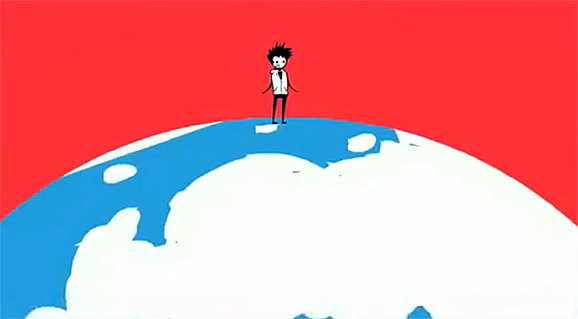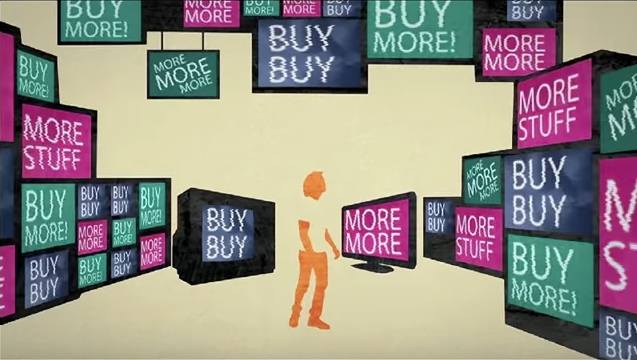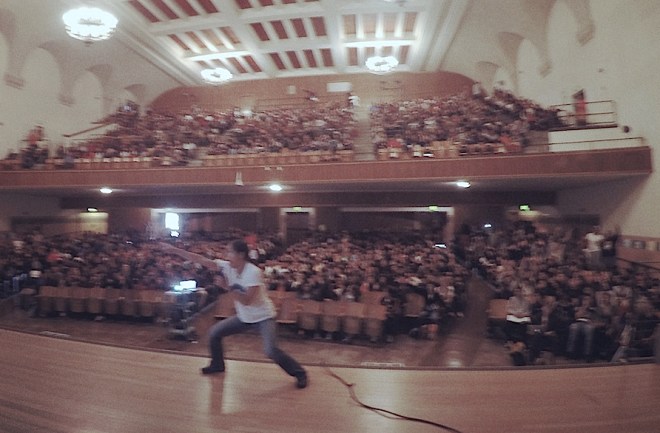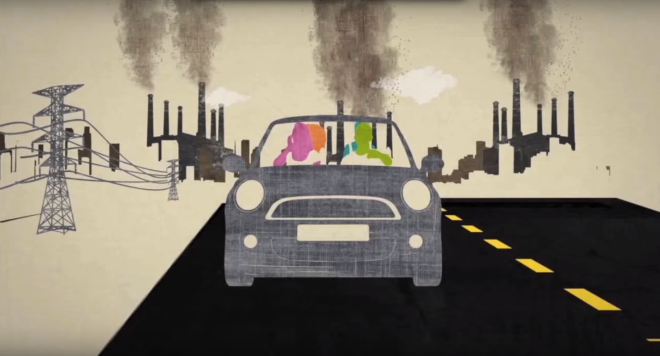Here’s a tip for the next time you’re explaining climate change to an auditorium full of teenagers: Never say the word “exacerbate.” Really, just don’t. It may not sound that much like “masturbate,” but two syllables in common is more than enough for a roomful of 14- to 17- year-olds. Wen Lee, a former high school chemistry teacher and current educator with the Alliance for Climate Education (ACE), learned that one the hard way.
On this recent morning, I’ve traveled out to Balboa High, a public high school in San Francisco. I’m there to see what it’s like to explain to a bunch of teenagers that our weather is changing in unpleasant and difficult-to-predict ways, because (a) millions of years ago, microscopic plants and animals thoughtfully stored energy underground, and (b) today, the human adults around them won’t stop digging all of it up and setting it on fire. Grist had written about ACE before, but never gone to an actual, honest-to-goodness high school assembly. Explaining climate change to anyone isn’t easy. I wanted to see the process happening, in real time.
Here are some of the other things Wen Lee has learned: Keep introductions short. You can be serious, but don’t be somber. Don’t let students take out their cellphones, ever, unless it’s at the very end of the talk. If the crowd is rowdy, don’t assume that no one is listening. Lee spoke to one school in Richmond, Calif., where a third of the students talked all the way through her presentation. Several of them gave her the finger. But after the presentation, a few teenagers followed up with her anyway.
When she feels listeners getting restless, she can ask them questions and have them shout back the answers. Really obvious questions, like “What does the pine beetle eat?”, are usually the best — you need maximal response. The Bay Area prides itself on being diverse, but the schools, for the most part, aren’t. Private schools are white, public schools are most affirmatively not. When Lee watches videos of herself performing, she can see that the way that she talks to students changes from school to school. If she’s in one of the Bay Area schools that is mostly first- or second-generation immigrants from Asia, she won’t ask any questions at all, because they won’t answer. They’ve been taught that it’s rude to talk back to adults, even when an adult asks you to.
Lee has an ace up her sleeve with those kids: She used to be one of them. “I tell them, when I grew up, I was a super overachiever. I wanted to do all the activities and get straight A’s. I didn’t care about the environment. It didn’t have anything to do with me. But now I realize that it has everything to do with me.”
At first glance, you’d probably think that Lee’s climate pitch and Balboa High were made for each other. Balboa is, in fact, located within the geographical boundaries of San Francisco. It has environmental programs. It has solar panels. But it took Lee years to get in the door here. The reason so much environmental organizing happens on the college level is that getting into high schools is, in general, not easy for environmental activists and educators: It requires speaking two languages — that of the students who are the eventual audience, and that of the teachers and administrators who control access to them.
For example: Once upon a time, ACE had a cartoon mascot — a spiky-haired character named (wait for it …) Ace.

ACE
Ace was popular with the youth, less so with high school administrators. They thought that a cartoon character — even one who delivered a high-school-level science curriculum — was little-kid stuff. So a few years ago Ace went into retirement and was replaced with silhouettes similar to those you’d see in old iPod ads. This new look is more grownup, but also: silhouettes, by definition, don’t have expressions. Or faces, for that matter. They’re harder to connect with.
Another example: ACE used to be more geographically dispersed across the country — but in some schools, administrators were so skittish that it was tough to get into a classroom of even 30 students. Now the organization operates in fewer regions, but it aims to build relationships with those kids who really want to get involved. There’s a fellowship program, for example, for kids who want to learn political organizing.
Teenagers may be hard to get access to, but there are obvious advantages to focusing on them. High school is the last time in most of our lives that we find ourselves as part of a broad cross-section of human society that is compelled to actually, physically, be somewhere and listen to someone else tell us what is important. Not all of Balboa’s students will go on to college, although most of them will. The ones who do won’t necessarily have the time or the inclination to go to things like climate-change assemblies. They might be working, or finishing their homework, or falling in love, or doing the thousands of other things that people do when they can no longer be sent to mandatory all-school assemblies.
It’s been a long time since I’ve been at a school assembly; I’d forgotten how much compulsory yelling it involves. Before Lee is even introduced, the freshmen have to scream “freshmen!” really loud. Then sophomores have to scream “sophomore,” and so forth up through the grades. I feel anxious, and then I feel the stirrings of a deeply submerged recollection of a long-ago pep rally, which I push back down into my subconscious.
What’s clear, though, is that unlike my high school, this is a happy place. There’s a sweetness and jocularity between administrators and students that goes beyond the “warden and inmates” dynamic that I’ve seen during my reporting on other schools.
A teenage girl walks up on stage to introduce Lee. As she moves, the crowd chants Ty-ra! Ty-ra! “This is Wen Lee,” says Tyra, with perfect teenage hauteur. “She’s going to educate you on climate change. It was raining last night. It’s sunny today. She’s going to update y’all on that.”
It’s still not quite time for Lee to come out on stage, though. First, the teenagers have to scream “Balboa!” three times, really loud. Then three more cries of “Balboa!,” because the first three were apparently just for practice. After all that is done, the presentation can begin.
“Raise your hands if you know what climate change is,” says Lee. Almost all the hands in the auditorium go up.
“I’m sure the last thing you want is another person talking to you about the world’s problems,” says Lee. “Scientists have been telling us for years that climate change is real. You’re the generation that can actually solve it.”
Lee cues up a video, and what follows can only be described as An Inconvenient Truth on acid. The silhouettes go about their daily lives, while the infrastructure that enables their everyday activities — power plants, methane-emitting cows — pop up around them. The language is colloquial, but the science is a solid and coherent explanation of how greenhouse gases work.
[protected-iframe id=”30b799b01df6bda55639c904db9da381-5104299-12588942″ info=”https://www.youtube.com/embed/dkk8Z7EqRhI” width=”560″ height=”315″ frameborder=”0″ allowfullscreen=””]
“The earth’s thermostat is getting jacked up,” says one version of the video. “It’s not your fault. You were born into a culture of advertisers telling you it’s cool to buy more and more stuff … You’re just being a normal teenager, driving around, charging your phone, eating a burger from a gassy cow …” At this moment, the hamburger in the hand of one of the silhouetted characters onscreen lets out a loud fart — an old gag left over from the days of Ace-the-cartoon-character.
Lee’s presentation feels improvisational, and to a certain extent it is. While every high school she visits gets the same explanation of what climate change is, other parts of the presentation can be swapped in and out like building blocks. For example: The burgeoning field of climate change communication suggests that it’s not enough to just explain that climate change is happening; you need to connect it to events that your audience can relate to. And so the next phase of the presentation is a series of short videos of teenagers talking about the effects of climate change in their own communities — they’re meant to regionalize and personalize climate change. There’s a girl in Boston who talks about sea-level rise; another girl in Pennsylvania who talks about fracking; someone in a coal town near Kansas City talking about asthma; and so forth.
Today, Lee has chosen the video of the kid in braces who talks about the wildfires in Colorado — she figures it will speak to drought-plagued California residents. This video can sometimes backfire, because the kid it features is extremely young and androgynous-looking and certain assemblies can get carried away trying to figure out if he’s a boy or a girl.
The other video is a new one that Lee shot a month ago and rushed to ready for the assembly because it features an actual Californian — a teenager from Watsonville. At first, there’s a nervousness about him that sets off a rumble of laughter in the auditorium. When he isn’t in school, the teenager says, he and his family work in the fields of the Central Valley. “We need water to grow the crops,” he says, intently. The laughter dies down. “If the rain never comes back that would affect me and my family. Family is very important to me. I will do whatever I could in order to protect my family.” For whatever reason — maybe it’s the fact that the teen on screen is, like a significant percentage of Balboa’s student population, Latino — the crowd is won over.
The rest of the assembly is more conventional. There’s an upbeat “things you can actually do” segment, which sets up some unanticipated booing when a teenager from Mission High — a rival school — appears onscreen and describes organizing a prom with a bicycle-powered music system. The booing is only short-lived, though, and seems fairly good-natured. There’s the requisite shout-out to green jobs (you can be a home energy auditor!), and the equally requisite montage of celebrities and stylish, diverse teenagers delivering calls to action.
Because we live in the 2010s, there are also many, many hashtags. Each student is asked to “Do one thing,” or #dot. The #dots are easy — things like #thriftshop, #unplug, and #turboshower (i.e., “take shorter showers”). A few volunteers come on stage and talk about their #dots. “I’m going to walk all the time,” says one. “I’m going to turboshower,” says another. “I’m going to take the bus,” says the last one. “You ain’t got no quarters!” someone yells from the back of the auditorium.
When Lee’s presentation ends, the flood of teenagers leaving the auditorium is epic — like salmon trying to jostle their way upstream. This was about as great an audience of teenagers as anyone could hope for. They actually seemed to listen. A cynic might worry: Will they do anything as a result? But Lee, at least, is not a cynic.
Lee’s process of environmental discovery started this way: She majored in biology, and discovered, like so many nature-loving biology majors before her, that in college, studying nature means performing experiments on it. There was a set of homework assignments involving frogs that to Lee were patently unnecessary both from an educational and a moral perspective. She pushed back, and managed to make the assignments optional instead of mandatory.
After that, the floodgates were opened. Lee, like a lot of people who work for ACE, has a theater background — she actually had to submit a video of herself giving a talk as part of her job application. And so when she explains the process of becoming exponentially more environmentally aware, she breaks into a devastatingly accurate imitation of a college student aghast at discovering the many injustices of the world. “I was like, oh my gosh!” she says. “Where does food come from? Oh my gosh! Where do pants come from???”
Some people grow out of this level of earnestness; with Lee, it’s still going strong. When she got married a few years ago, she and her husband took Amtrak cross-country and had four different wedding receptions with geographically dispersed friends and relatives rather than feel guilty for the carbon emissions generated by people jetting in from all over the country.
Lee packs up her audio-visual equipment into a wheely suitcase and trundles it out the door, down the sidewalk. A few teachers from Balboa walk past her, stop, and demand high-fives.
Today, Lee has explained climate change to about 1,400 students; her career total to date is about 90,000. She is right that the responsibility for solving climate change does not fall on teenagers, who really do have enough to worry about. The teenagers did not invent coal mining. They did not build an economy around the internal combustion engine. They did not plan the Interstate Highway System. They did not redline the inner city and unfairly subsidize automobile-dependent neighborhoods at the suburban fringes. They did not defund public transit. They did not pave paradise to put up a parking lot. They did not hamstring the Kyoto Protocol.
But they will live through more of the results of those choices than the elders who made them. That’s worth an assembly, at least.







